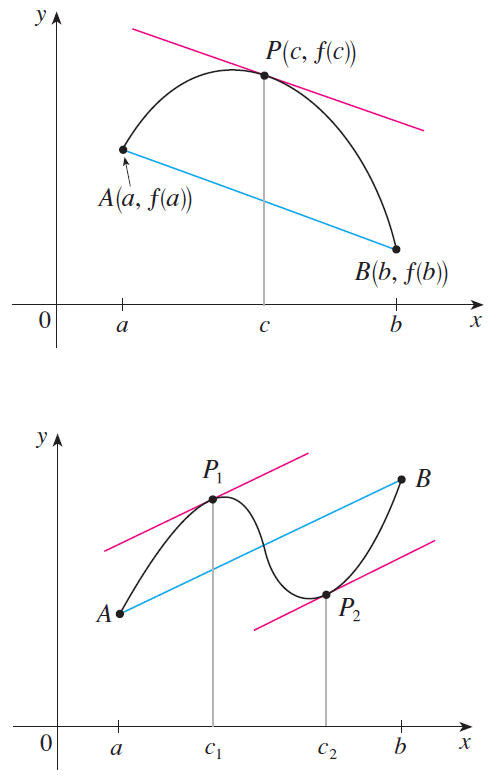SIMILAR SOLIDS WORKSHEET
Problem 1 :
Decide whether the two solids are similar. If so, compare the surface areas and volumes of the solids.

Problem 2 :
Decide whether the two solids are similar. If so, compare the surface areas and volumes of the solids.
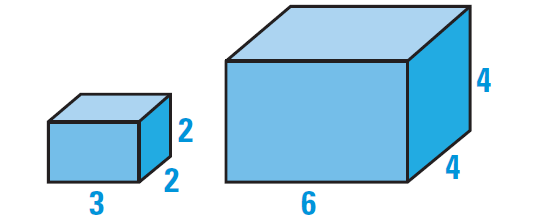
Problem 3 :
Find the scale factor of the two cubes shown below.
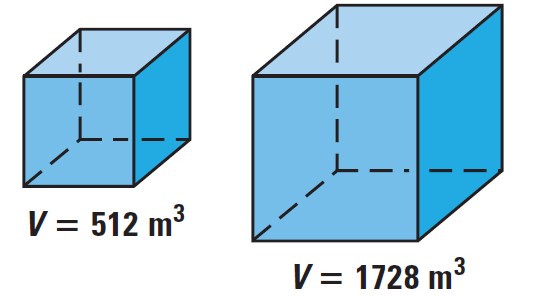
Problem 4 :
The prisms shown below are similar with a scale factor of 1:3. Find the surface area and volume of prism G given that the surface area of prism F is 24 square feet and the volume of prism F is 7 cubic feet.
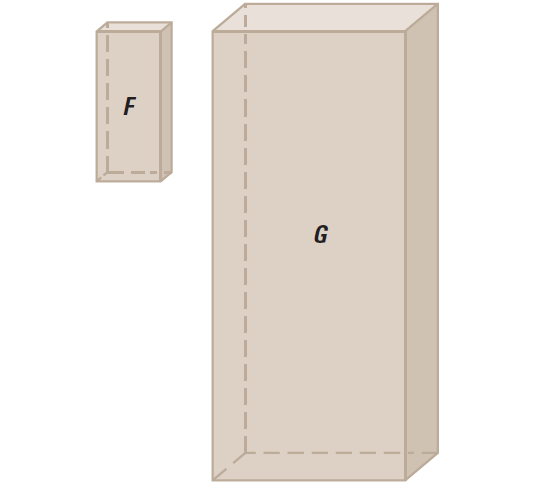
Problem 5 :
The lift power of a weather balloon is the amount of weight the balloon can lift. Find the missing measures in the table below, given that the ratio of the lift powers is equal to the ratio of the volumes of the balloons.

Problem 6 :
Two swimming pools are similar with a scale factor of 3 : 4. The amount of a chlorine mixture to be added is proportional to the volume of water in the pool. If two cups of the chlorine mixture are needed for the smaller pool, how much of the chlorine mixture is needed for the larger pool ?

Answers
Problem 1 :
Decide whether the two solids are similar. If so, compare the surface areas and volumes of the solids.

Solution :
Find the ratios of corresponding linear measures as shown below.
Lengths : 3/6 = 1/2
Widths : 2/4 = 1/2
Heights : 2/2 = 1/1
Because the ratios of corresponding linear measures are not equal, the solids are not similar.
Problem 2 :
Decide whether the two solids are similar. If so, compare the surface areas and volumes of the solids.

Solution :
Find the ratios of corresponding linear measures as shown below.
Lengths : 3/6 = 1/2
Widths : 2/4 = 1/2
Heights : 2/4 = 1/2
Because the ratios of corresponding linear measures are equal, the solids are similar.
The surface area and volume of the solids are as follows :
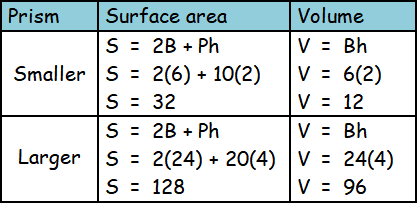
The ratio of side lengths is
= 1 : 2
The ratio of surface areas is
= 32 : 128
= 1 : 4
The ratio of volumes is
= 12 : 96
= 1 : 8
Problem 3 :
Find the scale factor of the two cubes shown below.

Solution :
To find the scale factor of the two cubes, find the ratio of the two volumes.
Write ratio of volumes.
a3 : b3 = 512 : 1728
Use a calculator to take the cube root.
a : b = 8 : 12
Simplify.
a : b = 2 : 3
So, the two cubes have a scale factor of 2 : 3.
Problem 4 :
The prisms shown below are similar with a scale factor of 1:3. Find the surface area and volume of prism G given that the surface area of prism F is 24 square feet and the volume of prism F is 7 cubic feet.

Solution :
Use Similar Solids Theorem to set up two proportion.
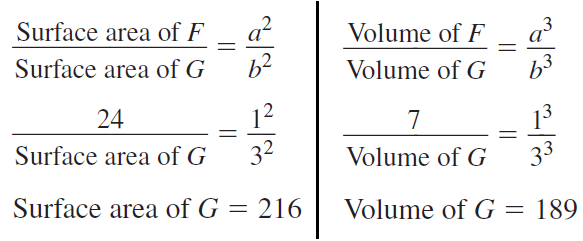
So, the surface area of prism G is 216 square feet and the volume of prism G is 189 cubic feet.
Problem 5 :
The lift power of a weather balloon is the amount of weight the balloon can lift. Find the missing measures in the table below, given that the ratio of the lift powers is equal to the ratio of the volumes of the balloons.

Solution :
Find the volume of the smaller balloon, whose radius is 4 feet.
Smaller Balloon :
V = 4/3 ⋅ πr3
Substitute 4 for r.
V = 4/3 ⋅ π(43)
Simplify.
V = 256π / 3
Use calculator.
V ≈ 85.3π ft3
The scale factor of the two balloons is
= 8 : 16
= 1 : 2
So, the ratio of the volumes is
= 13 : 23
= 1 : 8
To find the volume of the larger balloon, multiply the volume of the smaller balloon by 8.
Larger Balloon :
V ≈ 8(85.3π)
V ≈ 682.4π ft3
The ratio of the lift powers is 1 : 8. To find the lift power of the larger balloon, multiply the lift power of the smaller balloon by 8, as follows :
8(17) = 136 lb

Problem 6 :
Two swimming pools are similar with a scale factor of 3 : 4. The amount of a chlorine mixture to be added is proportional to the volume of water in the pool. If two cups of the chlorine mixture are needed for the smaller pool, how much of the chlorine mixture is needed for the larger pool ?
Solution :
Using the scale factor, the ratio of the volume of the smaller pool to the volume of the larger pool is as follows :
a3 : b3 = 33 : 43
a3 : b3 = 27 : 64
a3 : b3 ≈ 1 : 2.4
The ratio of the volumes of the mixtures is 1 : 2.4. The amount of the chlorine mixture for the larger pool can be found by multiplying the amount of the chlorine mixture for the smaller pool by 2.4 as follows :
2(2.4) = 4.8 c
So, the larger pool needs 4.8 cups of the chlorine mixture.
Kindly mail your feedback to v4formath@gmail.com
We always appreciate your feedback.
©All rights reserved. onlinemath4all.com
Recent Articles
-
Simplifying Algebraic Expressions with Fractional Coefficients
May 17, 24 08:12 AM
Simplifying Algebraic Expressions with Fractional Coefficients -
The Mean Value Theorem Worksheet
May 14, 24 08:53 AM
The Mean Value Theorem Worksheet -
Mean Value Theorem
May 14, 24 02:48 AM
Mean Value Theorem
